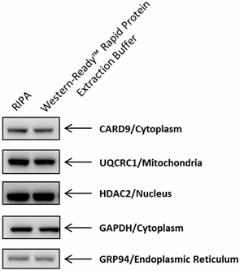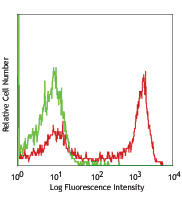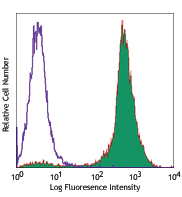- Regulatory Status
- RUO
- Other Names
- Lysis Buffer, Protein Buffer
- Ave. Rating
- Submit a Review
- Product Citations
- publications

-

Total cellular protein from Jurkat cells was extracted using RIPA buffer and Western-Ready™ Rapid Protein Extraction Buffer. Antibodies against targets from the indicated subcellular compartments were used to demonstrate extraction efficiency; purified anti-CARD9 antibody (Cat. No. 679102), purified anti-GAPDH antibody (Cat. No. 649202), purified anti-UQCRC1 antibody (Cat. No. 696202), purified anti-HDAC2 antibody (Cat. No. 815201) and purified anti-GRP94 antibody.
| Cat # | Size | Price | Quantity Check Availability | Save | ||
|---|---|---|---|---|---|---|
| 426305 | 100 mL | 141 CHF | ||||
Western-Ready™ Rapid Protein Extraction Buffer is a stringent lysis buffer that effectively extracts proteins from all subcellular compartments. Due to the rapid protein denaturation caused by high temperatures and high sodium dodecyl sulfate, this reagent does not require the use of protease inhibitors.
Product DetailsProduct Details
- Formulation
- 10 mM Tris-HCl pH 7.5, 1 mM Sodium orthovanadate, 1% Sodium dodecyl sulfate
- Storage & Handling
- Ambient RT
- Application
-
WB - Quality tested
- Recommended Usage
-
For rapid protein extraction from adherent cells:
- Grow cells as required
- Wash plate twice with PBS.
- Add 5-10 mL of lysis buffer to a glass pyrex bottle. Bring lysis buffer to boil over hot plate. Alternatively, 1 mL of lysis buffer can be heated in capped microfuge tubes at 100°C in heat block for 5 minutes. The screw cap of pyrex bottle containing lysis buffer must be loosened to avoid pressure build up. When bubbles form on the walls of the glass bottle, the lysis buffer is ready to add to cell pellets. To avoid over boiling remove lysis buffer from the heat plate to cool down and put it back to boil when you are ready to lyse the cells.
- Adjust pipette aid speed to slow, slowly draw boiling hot lysis buffer up and down to temper 2 mL serological pipette to heat.
- Add ~0.5 mL hot lysis buffer to each 10 cm plate. Lysis buffer volumes can be proportionately adjusted for different sized culture vessels. Turn hot plate off after use.
- Scrape and collect lysate with cell lifter using vertical top to bottom strokes.
- Sonicate samples as needed. Alternatively, samples can be passed several times through a 26-gauge needle.
- If insoluble material is observed, samples can be spun down at 16,000 g for 10 min at 15°C and the supernatant transferred to a new tube. Discard insoluble pellet.
- Store samples at -20 or -80° C.
For non-adherent cells:- Add 0.5 mL of boiling hot lysis buffer per 50 x106 cells after cells have been washed and pelleted and proceed from step 7 above.
For tissue:- Rapidly homogenize 0.25 mg of tissue in boiling lysis buffer and homogenize and microwave for 10-15 seconds. Proceed from step 7 above.
- Application Notes
-
During product development testing, Western-Ready™ Rapid Protein Extraction Buffer displayed 20% higher protein extraction efficiency compared to RIPA buffer (containing 0.1% SDS).
Due to the chaotropic and denaturing properties of Western-Ready™ Rapid Protein Extraction Buffer, it is not compatible with immunoprecipitation applications.
Due to high temperatures required for using Western-Ready™ Rapid Protein Extraction Buffer, the reagent may not be compatible with the extraction of multi-pass transmembrane proteins that are prone to aggregation.
Western-Ready™ Rapid Protein Extraction Buffer may solubilize DNA and cause the sample to become viscious. If this occurs, sonicate samples until the crude lysate can be easily drawn through a 200 µL pipette tip.
When thawing samples from -20°C or -80°C freezers, SDS precipitates will be observed if kept on ice. To resolubilize SDS, briefly incubate tubes in a 37°C water bath.
If Western-Ready™ Rapid Protein Extraction Buffer gets over-boiled it burns and its color changes from clear to yellowish. If this occurs, discard and boil new lysis buffer.
Antigen Details
- Gene ID
- NA
Related Pages & Pathways
Pages
Customers Also Purchased


 Login / Register
Login / Register 















Follow Us